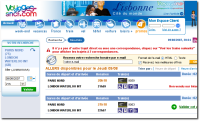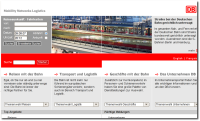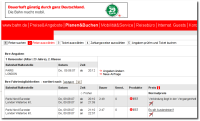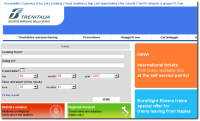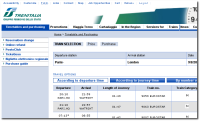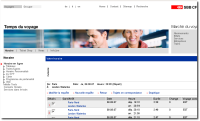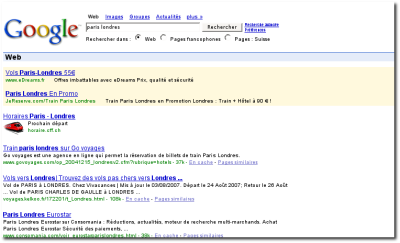It’s a fact that Switzerland is the country of the watches and the chocolate but also of the trains (because of the watches I guess). So the trains are expensive but almost on time. One thing that surprise me is that I’m still using the swiss web site to find a train between to cities in France, even sometimes the German one that knows about everything.
It’s not about nostaligia it’s because this one rocks by its simplicity. Clean and nothing else. I did a little sample to find how to go from Paris to London (nothing to see with Switzerland of Germany, but enjoy).
To start, the French one, la SNCF. I type sncf.fr which fails, corrected it to www.sncf.fr. Hell, what do I have to do now? After a couple of tries and my great experience I found that it’s Voyage SNCF where I have to click.
To get a results, I had to specify both starts and destination with a stupid popup and to wait on an advertisment. The web pages are full of advertisments and blinky pictures. A very bad experience, but I can buy a ticket at the end.
Now, let’s test from the british web site: National Rails Enquiries. The homepage is clean (see the screenshot) with some autocompletion, brilliant. But it doesn’t know where Paris is and fails miserably.
The german one is interesting because I could hear from french people that live in Germany that they are using it to buy tickets instead of the french one that could simply not for Germany (but the opposite is true). This is the first one that just does the job, it requires to fill its age in the process, that is weird just to know when there is a train to London.
Next one, is the Italy one. I’m not very keen in italian but it’s an interesting one because it’s the only one that has a liquid layout (100%). And in term of efficiency, great. I just entered the two cities and it gives me what I wanted.
And the last one, my favourite: SBB CFF FFS because I’m using it for a while and know how to find things quickly. During the process it asked me to specify the destination station, but already filled it with the most probable choice (the SNCF doesn’t do this sadly).
But seeing all these big interfaces with at least 4 inputs: start, destination, day and hour. Why not doing a simpler alternative: one field. I want to be able to ask: Paris London next Monday and to obtain what I’m asking. Google Switzerland does that for the cities only and it works quite well.
They are lots of bad example of fields that are to complicated. Compare LinkedId (or Xing) and Ziki (its little french cousin). The first one say: “keyword, name, company or title” (whatever in a word) and the second has two fields: “First Name” and “Last Name”, why?. As I’m sure that most of the people still use the mouse to switch from one input field to the next one, they should be more upsetted by this kind of user interface.
As a last reflection, it’s maybe not a good idea to mix concepts like where and when. Most of local services doesn’t mix what and where, but is that only a technical issue? I often don’t like them because they ask you to separate the idea you have. The natural language is very hard to process, but the solution I will use in the future is there.
I’d love to do a comparative between the ticket automat in the train station for different countries because the french one is so lame when you try the italian, german or swiss ones.
Rentrant de voyage où j’ai sillonné un bout de l’Europe géographique en train, je me suis rendu compte d’un truc très intéressant. Même vivant en France, et de ce fait prenant le train de temps à autre, j’utilise toujours le site des chemins de fer suisse car il fonctionne avec une grande simplicité.
Quand il ne va pas, je me tourne vers le site allemand qui lui fait tout, mais avec la barrière de la langue en plus. Il n’est pas rare qu’au guichet on vous dise non, et que le site allemand dise oui. Donc j’ai testé les différents pays pour un petit tour d’horizon. Mon itinéraire de test est Paris - Londres.
Le premier, le plus beau, la SNCF qui une fois que vous avez déniché la bonne URL contenant le formulaire, demande encore tout une gymnastique afin d’en faire sortir un horaire. Généralement il me demande de respécifier le lieu de départ et celui d’arrivée ce qui n’arrange rien au fait qu’il est plein de publicité clignotante. Parfois, s’en prendre à une borne automatique ou aux guichets est moins frustrant (parfois).
En passant sur le site de la Grande Bretagne, qui est très clean offrant rapidement beaucoup d’option et munit d’une autocomplétion (qui en fonction de ce qu’on a déjà entré propose les noms qu’il connait). Hélas, la modeste ville de Paris lui est inconnue, donc échec en puissance.
Enfin les trois qui sont utilisables: l’Italie (rien à redire), l’Allemagne (qui demande l’âge en court de route) et la Suisse (très simple).
Un point intéressant est que les bornes d’achat de tickets ont la même ergonomie entre les pays, la France étant une catastrophe de lenteur et les autres plutôt fonctionnels et clairs (je ne peux pas me prononcer sur la Grande-Bretagne).
Un point qui m'étonne est que ces sites offrent souvent au moins 4 champs pour un trajet : lui de départ, destination, jour et heure. Les deux dernier par toujours simple à manipuler. Google Suisse offre un moyen de demander son chemin via le moteur de recherche. En ne motionnant que deux villes, le premier résultat pointera sur l’horaire des CFF. Hélas, il ne permet pas encore de spécifier le quand avec une phrase du genre : « samedi prochain » ou « demain matin ».
Je suis certain que de minimiser le nombre de champs est un pari gagnant si l’expérience utilisateur en est grandie. Actuellement les services locaux séparent les idées du quoi, du où et du quand. Cette séparation n’est pas naturelle dans une première recherche et est imposée par la technique uniquement j’imagine.
Pour faire l’antithèse de mon point de vue à vouloir tout minimiser, offrir un point d’entrée aussi simple qu’un seul champ pour de multiple concept de lieu, temps et manière demande un apprentissage et tout le monde ne souhaite pas être confronté à ça.
Bref, un sujet à méditer.

